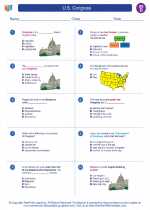What is the U.S. Congress?
The United States Congress is the legislative branch of the federal government. It is a bicameral body, meaning it has two separate chambers: the House of Representatives and the Senate. The main function of Congress is to make laws, but it also has other important powers, such as overseeing the executive branch and representing the interests of the American people.
House of Representatives
The House of Representatives is the larger chamber of Congress, with 435 members. The number of representatives from each state is based on its population. Members of the House are elected every two years and are responsible for introducing and voting on proposed laws.
Senate
The Senate is the smaller chamber of Congress, with 100 members - two from each state, regardless of population. Senators serve six-year terms, and their role is similar to that of the House in terms of lawmaking and oversight. The Vice President of the United States serves as the President of the Senate.
Powers of Congress
- Lawmaking: Congress has the power to make laws on a wide range of issues, including taxation, national defense, and commerce.
- Overseeing the Executive Branch: Congress can investigate the actions of the President and executive agencies to ensure they are acting in the best interest of the country.
- Representation: Members of Congress represent the interests of their constituents and advocate for policies that benefit their constituents and the nation.
How a Bill Becomes a Law
- A member of Congress introduces a bill in either the House or the Senate.
- The bill is referred to a committee for review and possible revisions.
- If the committee approves the bill, it is sent to the full chamber for debate and voting.
- If the bill passes in one chamber, it is then sent to the other chamber for consideration.
- If both chambers approve the bill, it is sent to the President for approval. The President can either sign the bill into law or veto it.
- If the President vetoes the bill, Congress can override the veto with a two-thirds majority vote in both chambers.
Checks and Balances
Congress plays a crucial role in the system of checks and balances by ensuring that no single branch of the government has too much power. It can pass laws, approve presidential appointments, and declare war, among other powers, to check the authority of the executive branch.
Conclusion
The U.S. Congress is a fundamental institution in the American political system. Understanding its structure, powers, and role in the government is essential for comprehending how laws are made and how the government functions.
.◂Social Studies Worksheets and Study Guides Fourth Grade. U.S. Congress

 Worksheet/Answer key
Worksheet/Answer key
 Worksheet/Answer key
Worksheet/Answer key
 Worksheet/Answer key
Worksheet/Answer key
